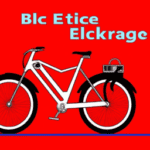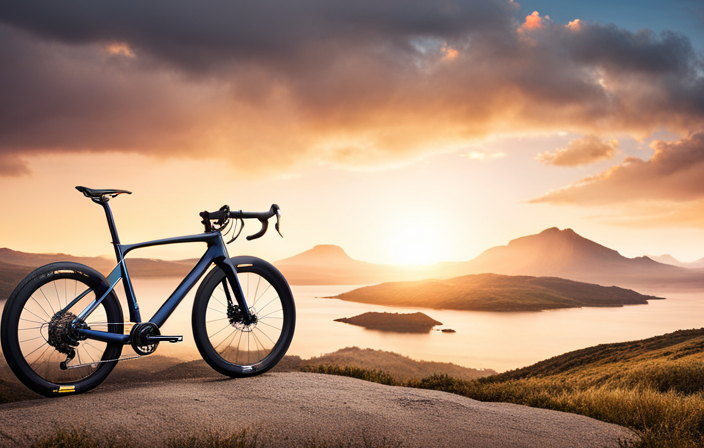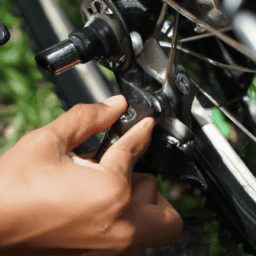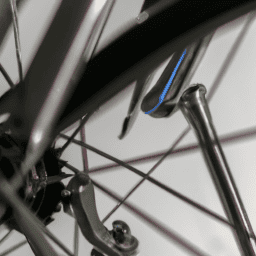Combining the convenience of a bicycle with the power of electricity, electric bikes are gaining popularity among commuters and outdoor enthusiasts.
But how much does this innovative mode of transportation actually cost?
In this comprehensive article, I will delve into the various factors that influence the price of electric bicycles, from the types and components to the range and performance.
Get ready to discover the true value of an electric bicycle and make an informed decision before your next purchase.
Types of Electric Bicycles
If you’re looking for different types of electric bicycles, you’ll find a wide variety available on the market. One of the key distinguishing features of electric bicycles is the type of motor they use.
There are three main types of electric bike motors: hub motors, mid-drive motors, and friction drive motors. Hub motors are the most common and are located in either the front or rear wheel. Mid-drive motors are positioned near the pedals, which provides better weight distribution and a more natural riding experience. Friction drive motors are less common and are attached to the side of the tire, offering a simpler design.
There are many benefits to using an electric bicycle, such as increased range, reduced effort when climbing hills, and the ability to easily commute long distances.
Moving on to electric bicycle components…
Electric Bicycle Components
When it comes to electric bicycles, understanding the key components is crucial. The motor, battery, and controller are the three main components that make an electric bicycle function.
The motor is responsible for providing the power and propulsion, while the battery stores the energy needed to run the motor.
The controller acts as the brain of the electric bicycle, regulating the power flow and ensuring smooth operation.
Knowing the details of these components will help you make an informed decision when choosing an electric bicycle.
Motor
The motor on an electric bicycle determines its power and speed. It is a crucial component responsible for propelling the bike forward. When considering an electric bicycle, it is important to understand motor efficiency, as it directly affects the overall performance and range.
A high-efficiency motor will provide better power output and a longer battery life. Regular maintenance and repairs are essential to ensure the motor operates optimally. This includes checking for any loose connections, cleaning the motor, and lubricating moving parts. If any issues arise, it is recommended to consult a professional for repairs.
Now, let’s transition to the next section about the battery, as it works in conjunction with the motor to power the electric bicycle.
Battery
The battery on an e-bike plays a crucial role in powering its motor and determining its overall performance. A high-quality battery has several advantages, such as providing a longer range per charge, allowing for faster speeds, and delivering consistent power output. Additionally, it can be charged quickly and has a longer lifespan compared to lower-quality batteries.
However, there are some disadvantages to consider as well. High-performance batteries can be expensive, making the overall cost of the electric bicycle higher. Moreover, they are often heavier, which can affect the handling and maneuverability of the bike. Another drawback is that the battery capacity may decrease over time, reducing the range and performance.
Transitioning into the subsequent section about the ‘controller,’ it is important to understand how this component works in conjunction with the battery.
Controller
To understand the controller, you need to grasp its role in managing the power from the battery. The controller is like the brain of an electric bicycle, responsible for regulating the flow of electricity to the motor. It determines how much power is delivered based on the rider’s input through the throttle or pedal assist system.
The controller features various settings that can be adjusted to customize the riding experience, such as speed limits and power modes. It is important to regularly maintain the controller to ensure optimal performance. This includes checking for loose connections, keeping it clean and dry, and avoiding extreme temperatures.
By taking care of the controller, you can prolong its lifespan and prevent any potential issues.
Now, let’s move on to the next section about the range and battery life.
Range and Battery Life
Did you know that electric bicycles can have a range of up to 100 miles on a single charge?
The range and battery life of an electric bicycle depend on various factors such as battery capacity and charging time.
The battery capacity determines how much energy the bike can store, while the charging time indicates how long it takes to fully charge the battery.
Generally, electric bicycles with larger battery capacities have longer ranges and can go further on a single charge. Similarly, shorter charging times allow for more frequent use of the bike without having to wait for the battery to recharge.
When it comes to performance and speed, electric bicycles offer an exhilarating experience, providing a smooth and effortless ride.
Performance and Speed
When it comes to the performance and speed of electric bicycles, there are several key points to consider.
First, the maximum speed of an electric bicycle can vary depending on the model and motor power.
Second, power assistance levels play a crucial role in determining how much assistance the motor provides while pedaling.
Lastly, climbing capabilities are important to assess if you live in an area with steep hills or if you plan on taking your electric bicycle off-road.
These factors are essential in understanding the overall performance and capabilities of an electric bicycle.
Maximum speed
The maximum speed of an electric bicycle varies depending on the model. It is important to consider power consumption and legal regulations when determining the maximum speed.
Electric bicycles typically have a maximum speed of around 20 to 28 miles per hour. However, some models can reach speeds of up to 45 miles per hour. The maximum speed is usually limited to comply with local regulations and ensure safety.
Higher speeds require more power consumption, which can affect the overall range of the electric bicycle. Therefore, it is crucial to balance speed and battery life when choosing an electric bicycle.
Moving on to power assistance levels, these settings allow riders to adjust the amount of assistance provided by the electric motor without compromising on speed.
Power assistance levels
Choose your desired power assistance level to adjust how much assistance the motor provides while maintaining your preferred speed. The power assistance levels on an electric bicycle determine the amount of support the motor offers while you pedal. These levels are typically controlled through a display or control panel on the handlebars. Most electric bicycles offer multiple power assistance levels, usually ranging from 1 to 5. Each level corresponds to a different amount of power assistance, with level 1 providing the least amount of assistance and level 5 offering the highest. The battery capacity of the electric bicycle will also affect the power assistance levels and how long the motor can provide assistance.
| Pedal Assist Level | Power Assistance |
|---|---|
| Level 1 | Low |
| Level 2 | Medium-low |
| Level 3 | Medium |
| Level 4 | Medium-high |
| Level 5 | High |
This table showcases the different pedal assist levels and their corresponding power assistance. Now that we have discussed power assistance levels, let’s move on to the climbing capabilities of electric bicycles.
Climbing capabilities
The climbing capabilities of e-bikes vary depending on the power assistance level selected. When it comes to tackling steep hills, e-bikes employ various climbing techniques to provide riders with a smooth and efficient experience. Here are four factors that contribute to an e-bike’s climbing capabilities:
-
Motor Power: The higher the wattage of the motor, the better the e-bike will be at climbing hills. More power means the motor can provide stronger assistance when pedaling uphill.
-
Torque: Torque is the force that the motor exerts to turn the wheels. E-bikes with higher torque ratings can handle steeper hill grades more easily.
-
Gear Ratio: E-bikes equipped with a wide range of gears allow riders to adjust their pedaling effort to match the terrain. This helps in maintaining a comfortable and efficient climbing speed.
-
Battery Capacity: A larger battery capacity ensures that the e-bike can maintain power assistance for longer periods, even while climbing steep hills.
Considering these factors, e-bike riders can enjoy the freedom of conquering challenging terrains with ease.
Now, let’s delve into the next section, where we will explore the exciting features and accessories available for e-bikes.
Features and Accessories
When it comes to features and accessories on an electric bicycle, there are a few key points to consider.
Firstly, lights and reflectors are essential for ensuring visibility and safety, especially when riding at night or in low light conditions.
Secondly, fenders and mudguards are important for protecting the rider from splashes and dirt, keeping them clean and dry.
Lastly, carriers and racks provide a convenient way to transport items, whether it’s groceries, a backpack, or even a small pet.
These features not only add functionality to an electric bicycle but also enhance the overall riding experience.
Lights and reflectors
I’m not sure about the cost, but it is important to have lights and reflectors on an electric bicycle.
Lights and reflectors are crucial for safety, especially when riding at night or in low light conditions. They help increase visibility to other road users, reducing the risk of accidents. Additionally, lights allow you to see the road ahead clearly, enhancing your own safety and confidence while riding.
When it comes to maintenance and upkeep, it is important to regularly check and replace the batteries in your lights to ensure they are always functioning properly. Reflectors should also be cleaned and inspected for any damage or wear.
Having functioning lights and reflectors on your electric bicycle is not only a legal requirement in many places, but it also provides peace of mind and enhances your overall riding experience.
Speaking of safety features, let’s now move on to discussing fenders and mudguards.
Fenders and mudguards
When it comes to electric bicycles, safety is key. In the previous section, we discussed the importance of lights and reflectors to ensure visibility on the road.
Now, let’s shift our focus to another crucial safety feature: fenders and mudguards. Fenders are essential in protecting you from splashes and debris while riding, especially in wet weather conditions. They also help keep your bike cleaner, reducing the need for frequent maintenance.
When choosing fenders, you have several options for materials, including plastic, aluminum, or carbon fiber. Each material has its own advantages and considerations, such as durability, weight, and cost. Additionally, proper fender installation is crucial to ensure they stay securely in place and provide optimal protection.
Now that we’ve covered fenders, let’s move on to the next section about carriers and racks, which are essential for transporting goods and luggage on your electric bicycle.
Carriers and racks
To transport your goods and luggage, you’ll need carriers and racks on your e-bike. These accessories provide convenient storage options and ensure that you can carry everything you need on your rides.
When selecting carriers and racks for your electric bicycle, it is important to consider compatibility with different bicycle models. Some carriers may be specifically designed for certain e-bike models, while others offer universal compatibility. Make sure to check the specifications and compatibility information provided by the manufacturer before making a purchase.
Additionally, consider the weight capacity and durability of the carriers and racks to ensure that they can safely hold your belongings.
Now, let’s move on to the next section, where we will discuss the importance of brand reputation and quality in choosing an electric bicycle.
Brand Reputation and Quality
When considering the brand reputation and quality of an electric bicycle, there are several key points to keep in mind.
Firstly, established brands often have a track record of producing reliable and durable products.
Secondly, customer reviews and ratings can provide valuable insights into the overall satisfaction and performance of a particular brand or model.
Lastly, the warranty and after-sales service offered by the brand can give reassurance and peace of mind in case any issues arise.
Taking these factors into consideration can help ensure that you choose an electric bicycle that is not only reputable but also of high quality.
Established brands
Electric bicycles from established brands can vary in price. When comparing prices of electric bikes from different established brands, it’s important to consider the features, components, and technology offered.
Higher-end models from well-known brands tend to have more advanced features, such as better battery life, higher motor power, and superior build quality. These factors can significantly impact the price. For instance, a renowned brand like Bosch might offer electric bikes with cutting-edge technology, resulting in a higher price tag compared to lesser-known brands.
However, it’s crucial to carefully analyze the specifications and determine if the additional cost is justified by the features provided.
Transitioning into the next section on customer reviews and ratings, it’s essential to consider the experiences and opinions of other users to make an informed decision.
Customer reviews and ratings
Looking at customer reviews and ratings can help inform your decision on which electric bike to choose. It’s important to gauge customer satisfaction with different models to ensure you’re making the right choice. After analyzing various reviews, I found that some popular electric bike models include the Rad Power Bikes RadRover, the Ancheer Electric Mountain Bike, and the Swagtron EB-5 Pro. These bikes have received high ratings for their performance, durability, and value for money. The table below provides a summary of the customer ratings for these models:
| Model | Customer Rating |
|---|---|
| RadRover | 4.8/5 |
| Ancheer Electric Bike | 4.6/5 |
| Swagtron EB-5 Pro | 4.7/5 |
Considering the positive feedback from customers, it’s clear that these models are well-regarded in the market. In the next section, we will discuss the warranty and after-sales service provided by these brands.
Warranty and after-sales service
To ensure you have peace of mind with your purchase, it’s important to consider the warranty and after-sales service offered by these brands.
When it comes to warranty coverage, it varies among electric bicycle brands. Some brands offer a comprehensive warranty that covers not only the frame, but also the motor, battery, and other components. This is important because it ensures that if anything goes wrong with your electric bicycle, you can rely on the manufacturer to provide support and assistance.
Additionally, customer support is crucial in case you have any questions or issues with your electric bicycle. Having a responsive and helpful customer support team can make a big difference in your overall experience.
Now, let’s transition into the next section about price range and budget considerations.
Price Range and Budget Considerations
If you’re on a budget, you’ll want to consider the price range of electric bicycles. Electric bicycles can vary widely in price, depending on factors such as brand, features, and quality. To give you an idea of the price comparison, I have created a table outlining the average price range of electric bicycles:
| Price Range | Description |
|---|---|
| $500-$1,000 | Basic models with limited features and lower quality components |
| $1,000-$2,000 | Mid-range models with better features and components |
| $2,000-$4,000 | High-end models with advanced features and superior components |
| $4,000+ | Premium models with top-of-the-line features and components |
When considering the price, it’s important to also think about financing options. Many electric bicycle retailers offer financing plans to help you spread out the cost over time. This can make purchasing an electric bicycle more affordable and manageable. As you think about the price range and financing options, it’s essential to keep in mind additional costs and considerations, which we’ll explore in the next section.
Additional Costs and Considerations
When considering an electric bicycle, it’s important to factor in the additional costs and considerations.
One of the main costs to consider is the cost of maintenance. While electric bicycles generally require less maintenance than traditional bikes, they still require regular upkeep such as tire replacements, brake adjustments, and battery maintenance. It’s important to budget for these regular maintenance costs to ensure that your electric bicycle remains in good working condition.
Another consideration is insurance coverage. While not all electric bicycles require insurance, it’s a good idea to check with your insurance provider to see if they offer coverage for electric bicycles. This can provide peace of mind in case of theft or damage to your electric bicycle.
Transitioning into the subsequent section about where to buy electric bicycles, it’s important to consider both the upfront cost and the long-term costs when making a purchasing decision.
Where to Buy Electric Bicycles
When it comes to buying electric bicycles, there are several options to consider.
One option is to visit local bike shops, where you can get expert advice and test ride different models.
Online retailers also offer a wide selection of electric bicycles, often at competitive prices.
Additionally, the second-hand market can be a great option for finding a more affordable electric bicycle, although it’s important to carefully inspect the bike and ensure it is in good condition.
Local bike shops
You can find electric bicycles at local bike shops. These shops are a great place to go if you want to see and test ride different models before making a purchase. They often have knowledgeable staff who can help you choose the right electric bicycle for your needs. In addition to offering a wide variety of brands and models, local bike shops also provide services such as maintenance and repairs.
Here is a comparison table of local bike shops and online retailers:
| Local Bike Shops | Online Retailers |
|---|---|
| Offers test rides and in-person assistance | Convenient online shopping experience |
| Knowledgeable staff to help with choosing the right model | Wide selection of brands and models |
| Provides maintenance and repair services | May offer lower prices |
When it comes to buying an electric bicycle, local bike shops offer a more personalized experience, while online retailers provide convenience and potentially lower prices.
Online retailers
Online retailers provide a wide selection of brands and models for customers to choose from. When considering purchasing an electric bicycle online, it is important to read online reviews to get a sense of the quality and performance of the bike. These reviews can give valuable insights into the pros and cons of different models, helping you make an informed decision.
Additionally, online retailers often offer customer support, allowing you to ask questions and get assistance before and after your purchase. This can be particularly helpful if you are new to electric bicycles and need guidance on assembly, maintenance, or troubleshooting.
Transitioning to the subsequent section about the second-hand market, it is worth mentioning that online retailers also provide a platform for buying and selling used electric bicycles, offering even more options for those looking for a more affordable or specific model.
Second-hand market
The second-hand market offers a variety of options for purchasing used e-bikes at affordable prices. When exploring the second-hand market for e-bikes, it’s important to consider the pricing trends to make an informed decision. Here are a few key points to keep in mind:
-
Wide Selection: The second-hand market provides a wide range of e-bike models, styles, and brands to choose from. Whether you’re looking for a compact city bike or a robust off-road option, there is something for everyone.
-
Competitive Pricing: Due to the nature of the second-hand market, prices for used e-bikes are often lower compared to buying new. This makes it a cost-effective option for those who want to experience electric cycling without breaking the bank.
-
Condition Assessment: When buying second-hand, it’s crucial to thoroughly assess the condition of the e-bike. Check the battery health, motor performance, and overall wear and tear to ensure you’re getting a reliable and well-maintained bike.
Transitioning into the next section, understanding the second-hand market and pricing trends is essential for making an informed decision when purchasing an e-bike.
Making an Informed Decision
When making an informed decision, it’s important to consider the cost of an electric bicycle.
Electric bicycle maintenance is one factor to consider. While the initial cost of purchasing an electric bicycle may be higher than a traditional bike, the maintenance costs can be lower in the long run. Electric bicycles have fewer moving parts and require less maintenance compared to cars or motorcycles. This can save on repair costs and time spent at the mechanic.
Additionally, electric bicycles have a lower environmental impact compared to other modes of transportation. They produce zero emissions and help reduce air pollution. By choosing an electric bicycle, not only can you save money on maintenance, but you can also contribute to a cleaner and greener environment.
Frequently Asked Questions
Are electric bicycles allowed on public roads and bike lanes?
Yes, electric bicycles are allowed on public roads and bike lanes. They offer numerous safety benefits, such as enhanced visibility and easier maneuverability. Additionally, they provide a more efficient and eco-friendly mode of transportation.
Can I ride an electric bicycle in the rain or snow?
Yes, you can ride an electric bicycle in the rain or snow. They are designed to withstand different weather conditions. The benefits include increased traction, stability, and the ability to navigate through challenging terrains.
Are there any maintenance requirements specific to electric bicycles?
Maintenance tips for electric bicycles include regular cleaning, checking tire pressure, and lubricating the chain. Common problems can include battery issues and motor malfunctions. Regular maintenance helps ensure optimal performance and longevity of the bike.
How long does it take to fully charge an electric bicycle battery?
To fully charge an electric bicycle battery, it typically takes around 4-6 hours. However, the charging speed can vary depending on the battery capacity and charger used. It’s important to note that fast charging may have a slight impact on the overall battery life.
Are there any age restrictions for riding an electric bicycle?
Yes, there are age restrictions for riding an electric bicycle. Safety regulations vary by country, but generally, riders must be at least 16 years old. These regulations aim to ensure the safety of both the rider and others on the road.
Conclusion
After carefully considering the various types, components, and features of electric bicycles, it is clear that they offer a thrilling and efficient mode of transportation.
With their impressive range and battery life, coupled with top-notch performance and speed, electric bicycles are a game-changer in the world of cycling.
However, it is important to note that the price range of electric bicycles can vary greatly, so it is essential to assess your budget and additional costs beforehand.
Armed with this knowledge, you can confidently embark on your electric bicycle journey, ready to explore the world with sustainable and exhilarating freedom.
















